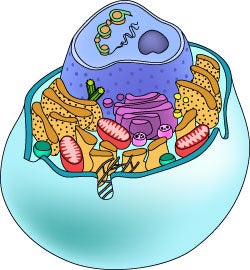Animal Cell Organelles Biography
Source:- Google.com.pk
Cell Organelles
All cells, whether they are prokaryotic or eukaryotic, have some common features. These common features are:
DNA, the genetic material contained in one or more chromosomes and located in a nonmembrane bound nucleoid region in prokaryotes and a membrane-bound nucleus in eukaryotes
Plasma membrane, a phospholipid bilayer with proteins that separates the cell from the surrounding environment and functions as a selective barrier for the import and export of materials
Cytoplasm, the rest of the material of the cell within the plasma membrane, excluding the nucleoid region or nucleus, that consists of a fluid portion called the cytosol and the organelles and other particulates suspended in it
Ribosomes, the organelles on which protein synthesis takes place
Prokaryotic cells are fundamentally different in their internal organization from eukaryotic cells. Notably, prokaryotic cells lack a nucleus and membranous organelles. Prokaryotic cells have the following features:
1. The genetic material (DNA) is localized to a region called the nucleoid which has no surrounding membrane.
2. The cell contains large numbers of ribosomes that are used for protein synthesis.
3. At the periphery of the cell is the plasma membrane. In some prokaryotes the plasma membrane folds in to form structures called mesosomes, the function of which is not clearly understood.
4. Outside the plasma membrane of most prokaryotes is a fairly rigid wall which gives the organism its shape. The walls of bacteria consist of peptidoglycans. Sometimes there is also an outer capsule. Note that the cell wall of prokaryotes differs chemically from the eukaryotic cell wall of plant cells and of protists.
5. Some bacteria have flagella which are used for locomotion and/or pili, which may be used to pull two cells in close contact, and perhaps to facilitate the transfer of genetic material.
Eukaryotic cells contain a membrane-bound nucleus and numerous membrane-enclosed organelles (e.g., mitochondria, lysosomes, Golgi apparatus) not found in prokaryotes. Animals, plants, fungi, and protists are all eukaryotes. Eukaryotic cells are more complex than prokaryotic cells and are found in a great many different forms.
The nucleus contains most of the genetic material (DNA) of the cell. Additional DNA is in the mitochondria and (if present) chloroplasts. The nuclear DNA is complexed with proteins to form chromatin, which is organized as a number of linear chromosomes. Genetic control of the cell is carried out by the production of RNA in the nucleus (the process of transcription) and the subsequent transfer of this RNA to a ribosome in the cytoplasm, where protein synthesis (the process of translation) is directed. The resulting proteins carry out cell functions. Also located in the nucleus is the nucleolus or nucleoli, organelles in which ribosomes are assembled. The nucleus is bounded by a nuclear envelope, a double membrane perforated with pores and connected to the rough endoplasmic reticulum membrane system.
The cytoskeleton consists of microtubules, intermediate fibers, and microfilaments, which together maintain cell shape, anchor organelles, and cause cell movement. The microtubules and microfilaments are frequently assembled and disassembled according to cellular needs for movement and maintaining cell shape. Intermediate filaments are more permanent than microtubules and microfilaments.
The cell diagrams shown here represent intestinal epithelial cells with fingerlike projections, the microvilli. The location and appearance of cytoskeletal fibers in different cell types will vary.
A ribosome is the site of protein synthesis in the cell. Each ribosome consists of a large subunit and a small subunit, each of which contains rRNA (ribosomal RNA) and ribosomal proteins. In protein synthesis the mRNA (messenger RNA) moves through the ribosome while amino acids attached to tRNAs (transfer RNAs) are brought to the ribosome. The amino acids are joined to produce the protein. You may access more information on From Gene to Protein: Translation. Ribosomes exist free in the cytoplasm and bound to the endoplasmic reticulum (ER). Free ribosomes synthesize the proteins that function in the cytosol, while bound ribosomes make proteins that are distributed by the membrane systems, including those which are secreted from the cell.
The plasma membrane (also called the cell membrane) is a phospholipid bilayer with embedded proteins that encloses every living cell. This membrane blocks uncontrolled movements of water-soluble materials into or out of the cell. The various proteins embedded in the phospholipid bilayer penetrate into and through the bilayer three-dimensionally. It is the proteins of the membrane that are responsible for the specific functions of the plasma membrane. These functions include controlling the flow of nutrients and ions into and out of the cells, mediating the response of a cell to external stimuli (a process called signal transduction), and interacting with bordering cells. All membranous eukaryotic cell organelles have the common feature of a phospholipid bilayer, although the proteins differ in each case.
Animal Cell Organelles Animal Cell Model Diagram Project Parts Structure Labeled Coloring and Plant Cell Organelles Cake


Animal Cell Organelles Animal Cell Model Diagram Project Parts Structure Labeled Coloring and Plant Cell Organelles Cake


Animal Cell Organelles Animal Cell Model Diagram Project Parts Structure Labeled Coloring and Plant Cell Organelles Cake


Animal Cell Organelles Animal Cell Model Diagram Project Parts Structure Labeled Coloring and Plant Cell Organelles Cake


Animal Cell Organelles Animal Cell Model Diagram Project Parts Structure Labeled Coloring and Plant Cell Organelles Cake


Animal Cell Organelles Animal Cell Model Diagram Project Parts Structure Labeled Coloring and Plant Cell Organelles Cake


Animal Cell Organelles Animal Cell Model Diagram Project Parts Structure Labeled Coloring and Plant Cell Organelles Cake


Animal Cell Organelles Animal Cell Model Diagram Project Parts Structure Labeled Coloring and Plant Cell Organelles Cake


Animal Cell Organelles Animal Cell Model Diagram Project Parts Structure Labeled Coloring and Plant Cell Organelles Cake


Animal Cell Organelles Animal Cell Model Diagram Project Parts Structure Labeled Coloring and Plant Cell Organelles Cake


Animal Cell Organelles Animal Cell Model Diagram Project Parts Structure Labeled Coloring and Plant Cell Organelles Cake
No comments:
Post a Comment